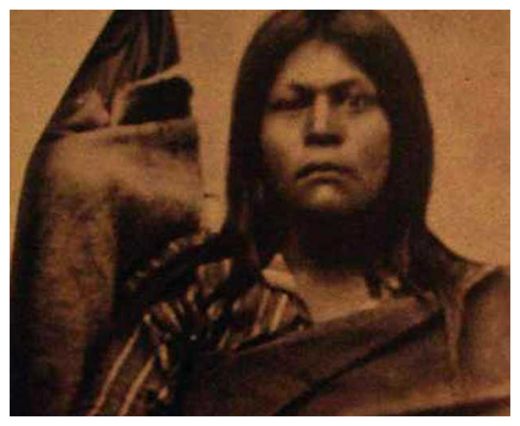
© Wikimedia CommonsA photo of the Lone Woman of San Nicolas Island.
Archaeologists might have finally found the cave of the Lone Woman of San Nicolas Island, whose solitary 18-year stay on a tiny island off the California coast inspired the children's classic
Island of the Blue Dolphins."The cave had been completely buried under several meters of sand. It is quite large and would have made a very comfortable home, especially in inclement weather," Navy archaeologist Steven Schwartz said at the California Islands Symposium last week in Ventura.
One of the most famous people associated with the Channel Islands, the Lone Woman belonged to the Nicoleno, a Native American tribe who lived on the remote wind-blasted island of San Nicolas off the Southern California coast.
The tribe was decimated in 1814 by sea otter hunters from Alaska. By 1835, less than a dozen Nicolenos lived on the island. At that time, the Santa Barbara Mission arranged a rescue operation which brought to the mainland all Nicoleños but the Lone Woman.
The most likely explanation for the abandonment is that a panicked crew, caught by a storm, turned the rescue schooner, named Peor es Nada ("Better Than nothing"), toward the mainland without much head counting.
The woman lived alone on the island until a fisherman and sea otter hunter found her in 1853 and brought her to the Santa Barbara Mission.
"She was found in a brush enclosure on the west end of the island, but she is believed to have lived in a cave during most of her 18 years of isolation," Schwartz, who has been investigating the island for more than 20 years, said.
Since there is no known habitation cave on the tiny island -- which is now a Navy base -- the archaeologist concluded that the cavern must have collapsed and been buried.
The search took a new twist recently, when Schwartz obtained a unique document: a government survey map of the island dated from 1879 which pointed to an "Indian Cave" on the southwest coast.
Preliminary excavation revealed a cave which is at least 75 feet long and 10 feet high.
According to Schwartz, ground-penetrating radar might show a layer of relics from the Lone Woman's era -- "perhaps even the markings she was said to have made on the walls," he told the
Los Angeles Times.
Further evidence for some sort of Robinson Crusoe struggling existence emerged two years ago from a steep cliff on the north coast of the island in the form of two redwood boxes.
They contained more than 200 objects, including shells, bone tools, harpoon points, bone fishhooks and even a smoking pipe.
It may never be known just who left the boxes, but "it's at least a reasonable hypothesis" that it was the Lone Woman, University of Oregon archaeologist Jon M. Erlandson told the
Los Angeles Times.
Although the Lone Woman managed to live alone for 18 years on the wild, tiny island, she did not last long when she came back to "civilization" at a possible age of 50.
She died from dysentery only seven weeks after she arrived to the Santa Barbara Mission, unable to communicate, but totally fascinated by the new life she was discovering.
Indeed, her great fondness for food such as green corn, vegetables and fresh fruit, was probably the cause for her fatal illness.
On her deathbed, the Lone Woman was baptised and christened Juana Maria.
All her personal possession, including the bone tools which had been brought back from San Nicolas Island, became part of the collections of the California Academy of Sciences, but were destroyed in the 1906 San Francisco earthquake and fire.
Reader Comments
They tell you right off the start that most of the people on the island were killed by Alaskans, then they tell you that they sent a rescue party, my ass. They probably killed all of them in the first place and maybe this one lady survived by hiding. Also they would speak a different language so a rescue party wouldn't have worked in the first place, especially after they had already been attacked by outsiders, do you really think they are going to welcome them with open arms the next time they come back? I mean come the fuck on and use your brain.
Question everything you read, stop accepting everything that's in text as truth you fucking idiots..... Analyze!!!!!!!!!!!!!!!!!!!!!!!!!!!!!!
The story has been well documented. Blades11 - get a life!